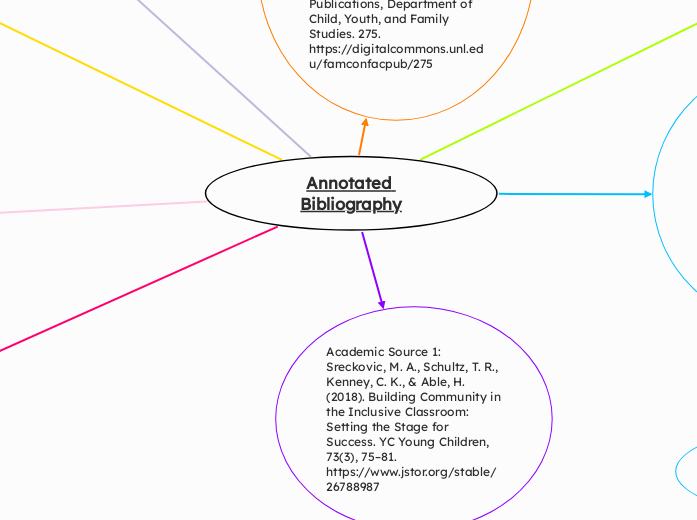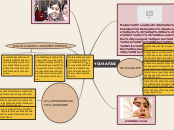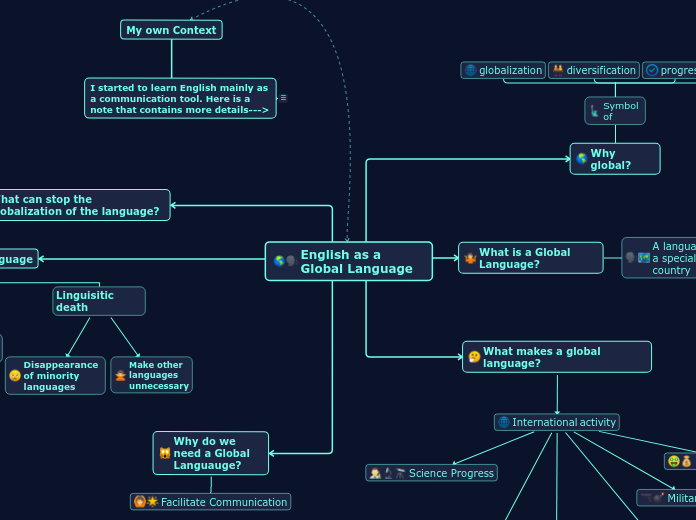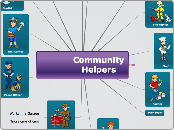Summary: The rating of ICP items in the 51 classrooms in the study ranged from the lowest to highest end of the scale. This article takes into account pretty much everything within the classroom like IEPs, class size, degree of the teacher, and more. You can analyze the data and ask yourself questions on why the results are the way they are.
Summary: This article sets the stage for success for creating an environment that is inclusive for all students. It gives strategies to use in the classroom and also focuses on friendships in the classroom as well.
Annotated Bibliography
Online Source 2: Molina Roldán, S., Marauri, J., Aubert, A., & Flecha, R. (2021, April 29). How inclusive interactive learning environments benefit students without special needs. Frontiers in psychology. https://pmc.ncbi.nlm.nih.gov/articles/PMC8116690/
I am connecting this source to Academic Source 4. These articles are connected it shows how inclusion impacts students who do not have disabilities.
Online Source 3: Inclusive Classrooms. Reading Rockets. (n.d.). https://www.readingrockets.org/helping-all-readers/inclusive-classrooms
I am connecting this source to Academic Source 1 and Academic Source 5. This article is connected to those two sources because there is information what an inclusive classroom is but also strategies for inclusion.
Online Source 1: Inclusive teaching strategies. Poorvu Center for Teaching and Learning. (2021, June 30). https://poorvucenter.yale.edu/InclusiveTeachingStrategies
I am connecting this online website to Academic Source 1. These sources are connected because they both give strategies on how to successfully and efficiently provide an inclusive classroom for your students. There are strategies, recommendations, and it will go in depth of how to do said things in your classroom.
Academic Source 3: Minott, M. (2019). Reflective teaching, inclusive teaching and the teacher’s tasks in the inclusive classroom: A literary investigation. British Journal of Special Education, 46(2), 226-238. https://doi.org/10.1111/1467-8578.12260
This source is different because it gives a literary review that features reflective teaching connect with and are fundamental to inclusive teaching.
It points out that
for inclusion to occur, this will involve changes in curriculum, lesson content, teaching
approaches, structures and strategies for all students (Minott, 2019).
Increasingly, the
application of inclusive teaching has become the dominant trend when addressing
students' difference in the classroom (Minott, 2019).
This is so because, firstly, it is
argued that to teach inclusively require teachers: shifting the focus from one that is
concerned with only students who have been identified as having ‘additional needs’ to
the learning of all children in the classroom, locating problems in the environment, rather
than as deficits in learners, focussing on what is to be taught (and how) rather than who is
to learn it and engaging in reflective responses to supporting difficulties students
encounter in their learning (Minott, 2019).
Summary: This article reveals that there are features of reflective teaching that connects with and are fundamental with inclusive teaching. Having knowledge of both of these teaching styles can be efficient in a classroom. There are features of reflective teaching addressed as well as tasks for implementing inclusiveness in the classroom. In the inclusive classroom, this means that the teacher should reflect on his or her classroom situation and constantly seeking out and trying new things to support all learners.
Academic Source 5:
Aderemi, T. J., Ángeles, P. R., Benjamin, E., & González H, C. A. (2022). Leadership for education. Regions & Cohesion : The Journal of the Consortium for Comparative Research on Regional Integration and Social Cohesion., 12(2), 48–78. https://doi.org/10.3167/reco.2022.120205
For example, teaching and cur- ricula must be adapted to suit the needs of every learner to facilitate classroom participation and learning (Aderemi, et al. 2022).
Good solutions include teacher training; disaggregation of education and socioeconomic data by disability, age, and gender; clear strategies for implementation of inclusive education policies and stigma-reduction strategies; prioritiza- tion of disability inclusion within social protection schemes; and making assistive technology available and affordable (Adremei, et al. 2022).
The most recent studies on childhood, disability, and education focus on the importance of generating models for the inclusion of children with disabilities in regular education: “It is about children with disabilities learning together with the rest of the children in regular schools and not creating special schools for their attention,” (Adremei, et al. 2022).
I am connecting this source to Academic Source 3. These sources are connected because of how much different information and aspects are included in them. Academic Source 2 shows a literary approach while Source 5 gives insight on how to carry out an inclusive classroom and the reason behind it.
This source is like has quite literally everything about inclusiveness, education, and more. It has so much information and facts that will share what it is and why we need it.
Summary: This article has two in one by the same author. They both cover facts and information about inclusion. In these specific ones, it talks about discrimination to those with disabilities which if inclusion is in play, discrimination wouldn't be a thing. There are various perspectives and more that come from these articles.
Academic Source 4: Hong, Soo-Young; Eum, Jungwon; Long, Yanjie; Wu, Chaorong; and Welch, Greg, "Typically Developing
Preschoolers’ Behavior Toward Peers with Disabilities in Inclusive Classroom Contexts" (2020). Faculty
Publications, Department of Child, Youth, and Family Studies. 275.
https://digitalcommons.unl.edu/famconfacpub/275
Highquality inclusive practices promote the physical and social integration of children with
disabilities in classrooms and communities, so they can build a sense of community as a
member of the society and form positive relationships with their typically developing peers (Hong, et al. 2020)
Their mission was to help children and
families become successful in a safe and inclusive environment and help everyone grow
and learn together (Hong, et al. 2020).
Our main
findings conclude that children without disabilities were more likely to interact with peers
with disabilities: (a) outdoors than indoors, (b) during child-directed or adult-directed activities rather than transitions and routines, and (c) during play activities rather than either
academic activities or transitions or routines (Hong, et al. 2020).
Summary: This article is another study that shows interactions between students with and without disabilities. There are many factors that went into this study like indoors vs. outdoors and type of activities. There is a lot of information packed into this article and findings that will give insight on more of the important of inclusivity.
I am connecting this source to Academic Source 2 because they are more study based. There are findings, studies, and percentages of various things that go into having an inclusive classroom and everything that goes into it.
This source investigates typically developed preschoolers' behavior towards peers with disabilities. It shows in the interactions between students with and without disabilities. Activity contexts contribute to teachers needing more support and training with inclusive and collaborative practices.
Academic Source 2: Soukakou, E. P., Winton, P. J., West, T. A., Sideris, J. H., & Rucker, L. M. (2014). Measuring the Quality of Inclusive Practices: Findings From the Inclusive Classroom Profile Pilot. Journal of Early Intervention, 36(3), 223-240. https://www.proquest.com/scholarly-journals/measuring-quality-inclusive-practices-findings/docview/1677157772/se-2
Ratings on the ICP items indicate the extent to which program
staff intentionally adapt the classroom’s environment, activities, and instructional support in
ways that encourage children’s active participation in the group, through adjustments that might
differ from child to child (Soukakou, et al. 2014).
The policy initiatives supporting inclusion which have developed over the past 3 decades have
been accompanied by research that has advanced the field’s knowledge of early childhood inclusion and the research-based practices that
support effective implementation of inclusion in early childhood settings (Soukakou, et al. 2014).
Classroom and teacher
information included characteristics such as class size, number of adults present in the classroom
during ICP assessments, teachers’ level of qualifications, years of teaching experience in an
inclusive classroom, and amount of special education coursework (Soukakou, et al. 2014).
Main topic
This source is a study that tests the reliability and validity of the Inclusive Classroom Profile. I will use the results and the information provided from the study, to show how the ICP is in preschool classrooms.
Academic Source 1: Sreckovic, M. A., Schultz, T. R., Kenney, C. K., & Able, H. (2018). Building Community in the Inclusive Classroom: Setting the Stage for Success. YC Young Children, 73(3), 75–81. https://www.jstor.org/stable/26788987
How Will I Use This Source?
This source provides research and provides strategies that will set the foundation for a socially inclusive environment for all children.
3 Quotes or Paraphrases
Research has documented improvement in social outcomes of young children with disabilities through the value of each member in the classroom community, the class can celebrate uniqueness throughout the year.
Developing an environment
where students feel they belong, are valued, and care
about one another will set the stage for them to form
positive peer relationships and acquire social skills, and
will reflect a successful inclusive environment.
With the
overall goals of fostering friendships and developing a
caring community of learners, teachers can create an
atmosphere where all children feel comfortable taking
risks and are accepting of one another.









